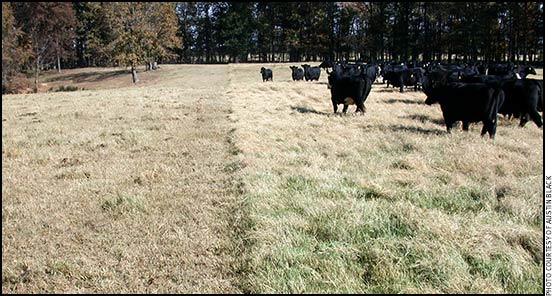
300 Days of Grazing
University of Arkansas professor outlines a 300-day grazing plan.
Imagine feeding hay for only 65 days each year. Not only does the scenario save time and money, it’s a lot easier to do than people think. Professors from the University of Arkansas Animal Science Department have developed a plan to do it.

John Jennings
The program has five steps to manage current forage resources and maximize grazing opportunity.
“The key of a 300-day grazing program is working with producers on forage already on hand. In most cases, the forage is already there; it just needs better management,” said John Jennings, University of Arkansas forage professor.
Step 1: Inventory your current forage base.
This step helps producers determine what forage is present on their operation. Producers can use a notepad or get an inventory sheet from University of Arkansas Extension to record what is in their pasture. The total calculation is a percentage based on 100 data points in the pasture. The practice gives producers a snapshot of their available forage. Doing inventory helps determine what forage is available and how to manage each pasture. It also helps producers plan grazing for each season.
Step 2: Establish management practices to increase seasonal grazing.
Before planting new forages, producers should manage to increase the use of current resources.
“If you’re not doing rotational grazing, start,” Jennings said. Managed grazing doesn’t have to be intensive. Any form of rotational grazing keeps grass growing longer.
Stockpiling fescue or Bermuda grass is an easy way to extend grazing and reduce the amount of hay needed. The best way to reduce waste when feeding hay is using a ring or feeder and moving it every time you feed.
If producers decide to unroll their hay, it’s important to ensure cattle eat it quickly. Feeding hay in different spots spreads nutrients across the pasture, but those nutrients often aren’t enough to maintain proper fertility for continued forage growth. Jennings said producers should fertilize specific pastures for each grazing season rather than all at once.
Step 3: Add complementary forages to fill in seasonal gaps.
The goal of a 300-day grazing program is to provide forage through as much of the fall and winter as possible. It’s also ensuring grazing opportunity during summer droughts. The goal of complementary forages is to fill in the gaps and continue grazing as long as possible.
“Look at the different seasons, and see what options fit and how,” Jennings said.
Step 4: Plan ahead for forage and grazing practices.
Producers should start their 300-day grazing program by planning one season ahead.
“Once they get experience, plan for a full year,” Jennings said. Often, the timing and method doesn’t change much year to year. The key is knowing when forages will grow, what forage gaps are present and having a plan beforehand.
Step 5: Monitor and adjust as needed.
Watch how pastures handle grazing and if adjustments are needed to maximize grazing opportunity.
“Keep simple notes on a calendar,” Jennings said. “Keep track of what you did and the results so if it works out well you can repeat it. If it didn’t work out, understand why so you can manage differently.”
For more information, see the full article on page 22 of the September Angus Beef Bulletin.
Editor’s Note: Austin Black is a freelancer and cattleman from Nevada, Mo.







